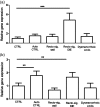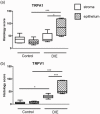Local upregulation of transient receptor potential ankyrin 1 and transient receptor potential vanilloid 1 ion channels in rectosigmoid deep infiltrating endometriosis
- PMID: 28478727
- PMCID: PMC5424991
- DOI: 10.1177/1744806917705564
Local upregulation of transient receptor potential ankyrin 1 and transient receptor potential vanilloid 1 ion channels in rectosigmoid deep infiltrating endometriosis
Abstract
Transient Receptor Potential Vanilloid 1 (TRPV1) and Transient Receptor Potential Ankyrin 1 (TRPA1) expressed mainly by primary sensory neurons function as major nociceptive integrators. They are also present on the rat endometrium in an oestrogen-regulated manner. TRPV1 is upregulated in peritoneal and ovarian endometriosis patients, but there is no information about TRPA1 and their pathophysiological significances. In this study, patients undergoing laparoscopic surgery were investigated: severe dysmenorrhoea due to rectosigmoid deep infiltrating endometriosis ( n = 15), uterine fibroid-induced moderate dysmenorrhoea ( n = 7) and tubal infertility with no pain ( n = 6). TRPA1 and TRPV1 mRNA and protein expressions were determined by quantitative polymerase chain reaction and semi-quantitative immunohistochemistry from the endometrium samples taken by curettage. Results were correlated with the clinical characteristics including pain intensity. TRPA1 and TRPV1 receptors were expressed in the healthy human endometrium at mRNA and protein levels. Sparse, scattered cytoplasmic TRPA1 and TRPV1 immunopositivities were found in the stroma and epithelial layers. We detected upregulated mRNA levels in deep infiltrating endometriosis lesions, and TRPV1 gene expression was also elevated in autocontrol endometrium of deep infiltrating endometriosis patients. Histological scoring revealed significant TRPA1 and TRPV1 difference between deep infiltrating endometriosis stroma and epithelium, and in deep infiltrating endometriosis epithelium compared to control samples. Besides, we measured elevated stromal TRPV1 immunopositivity in deep infiltrating endometriosis. Stromal TRPA1 and TRPV1 immunoreactivities strongly correlated with dysmenorrhoea severity, as well TRPV1 expression on ectopic epithelial cells and macrophages with dyspareunia. Epithelial TRPA1 and stromal TRPV1 immunopositivity also positively correlated with dyschezia severity. We provide the first evidence for the presence of non-neuronal TRPA1 receptor in the healthy human endometrium and confirm the expression of TRPV1 channels. Their upregulations in rectosigmoid deep infiltrating endometriosis lesions and correlations with pain intensity suggest potential roles in pathophysiological mechanisms of the disease.
Keywords: Dysmenorrhoea; endometriosis; pain; transient receptor potential ankyrin 1; transient receptor potential vanilloid 1.
Figures




Similar articles
-
TRPV1 and TRPA1 stimulation induces MUC5B secretion in the human nasal airway in vivo.Clin Physiol Funct Imaging. 2011 Nov;31(6):435-44. doi: 10.1111/j.1475-097X.2011.01039.x. Epub 2011 Jul 26. Clin Physiol Funct Imaging. 2011. PMID: 21981454 Clinical Trial.
-
Functional Transient Receptor Potential Ankyrin 1 and Vanilloid 1 Ion Channels Are Overexpressed in Human Oral Squamous Cell Carcinoma.Int J Mol Sci. 2022 Feb 8;23(3):1921. doi: 10.3390/ijms23031921. Int J Mol Sci. 2022. PMID: 35163843 Free PMC article.
-
Estrogen-dependent up-regulation of TRPA1 and TRPV1 receptor proteins in the rat endometrium.J Mol Endocrinol. 2016 Feb;56(2):135-49. doi: 10.1530/JME-15-0184. Epub 2015 Dec 7. J Mol Endocrinol. 2016. PMID: 26643912
-
TRP channels in cancer pain.Eur J Pharmacol. 2021 Aug 5;904:174185. doi: 10.1016/j.ejphar.2021.174185. Epub 2021 May 17. Eur J Pharmacol. 2021. PMID: 34015320 Review.
-
Regulation of nociceptive transmission at the periphery via TRPA1-TRPV1 interactions.Curr Pharm Biotechnol. 2011 Jan 1;12(1):89-94. doi: 10.2174/138920111793937952. Curr Pharm Biotechnol. 2011. PMID: 20932255 Review.
Cited by
-
An Update on the Multifaceted Role of NF-kappaB in Endometriosis.Int J Biol Sci. 2022 Jul 4;18(11):4400-4413. doi: 10.7150/ijbs.72707. eCollection 2022. Int J Biol Sci. 2022. PMID: 35864971 Free PMC article. Review.
-
Digestive system deep infiltrating endometriosis: What do we know.J Cell Mol Med. 2023 Dec;27(23):3649-3661. doi: 10.1111/jcmm.17921. Epub 2023 Aug 25. J Cell Mol Med. 2023. PMID: 37632165 Free PMC article. Review.
-
Role of the endocannabinoid system in the pathophysiology of endometriosis and therapeutic implications.J Cannabis Res. 2022 Oct 7;4(1):54. doi: 10.1186/s42238-022-00163-8. J Cannabis Res. 2022. PMID: 36207747 Free PMC article. Review.
-
TRPA1 Role in Inflammatory Disorders: What Is Known So Far?Int J Mol Sci. 2022 Apr 20;23(9):4529. doi: 10.3390/ijms23094529. Int J Mol Sci. 2022. PMID: 35562920 Free PMC article. Review.
-
Role of the gut microbiota in the pathogenesis of endometriosis: a review.Front Microbiol. 2024 Mar 5;15:1363455. doi: 10.3389/fmicb.2024.1363455. eCollection 2024. Front Microbiol. 2024. PMID: 38505548 Free PMC article. Review.
References
-
- Jamieson DJ, Steege JF. The prevalence of dysmenorrhea, dyspareunia, pelvic pain, and irritable bowel syndrome in primary care practices. Obstet Gynecol 1996; 87: 55–58. - PubMed
-
- Berkley KJ. A life of pelvic pain. Physiol Behav 2005; 86: 272–280. - PubMed
-
- Nisolle M, Donnez J. Peritoneal endometriosis, ovarian endometriosis, and adenomyotic nodules of the rectovaginal septum are three different entities. Fertil Steril 2016; 5: 585–596. - PubMed
Publication types
MeSH terms
Substances
LinkOut - more resources
Full Text Sources
Other Literature Sources
Medical

